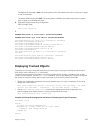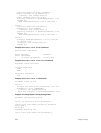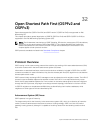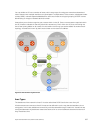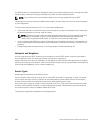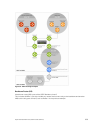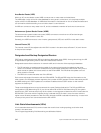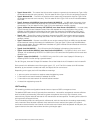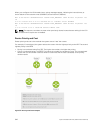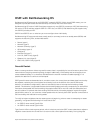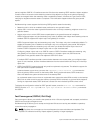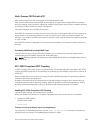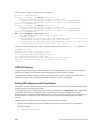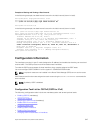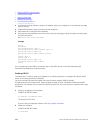• Type 1: Router LSA — The router lists links to other routers or networks in the same area. Type 1 LSAs
are flooded across their own area only. The link-state ID of the Type 1 LSA is the originating router ID.
• Type 2: Network LSA — The DR in an area lists which routers are joined within the area. Type 2 LSAs
are flooded across their own area only. The link-state ID of the Type 2 LSA is the IP interface address
of the DR.
• Type 3: Summary LSA (OSPFv2), Inter-Area-Prefix LSA (OSPFv3) — An ABR takes information it has
learned on one of its attached areas and can summarize it before sending it out on other areas it is
connected to. The link-state ID of the Type 3 LSA is the destination network number.
• Type 4: AS Border Router Summary LSA (OSPFv2), Inter-Area-Router LSA (OSPFv3) — In some cases,
Type 5 External LSAs are flooded to areas where the detailed next-hop information may not be
available. An ABR floods the information for the router (for example, the ASBR where the Type 5
advertisement originated. The link-state ID for Type 4 LSAs is the router ID of the described ASBR).
• Type 5: LSA — These LSAs contain information imported into OSPF from other routing processes.
They are flooded to all areas, except stub areas. The link-state ID of the Type 5 LSA is the external
network number.
• Type 7: External LSA — Routers in an NSSA do not receive external LSAs from ABRs, but are allowed
to send external routing information for redistribution. They use Type 7 LSAs to tell the ABRs about
these external routes, which the ABR then translates to Type 5 external LSAs and floods as normal to
the rest of the OSPF network.
• Type 8: Link LSA (OSPFv3) — This LSA carries the IPv6 address information of the local links.
• Type 9: Link Local LSA (OSPFv2), Intra-Area-Prefix LSA (OSPFv3) — For OSPFv2, this is a link-local
"opaque" LSA as defined by RFC2370. For OSPFv3, this LSA carries the IPv6 prefixes of the router and
network links.
• Type 11 - Grace LSA (OSPFv3) — For OSPFv3 only, this LSA is a link-local “opaque” LSA sent by a
restarting OSPFv3 router during a graceful restart.
For all LSA types, there are 20-byte LSA headers. One of the fields of the LSA header is the link-state ID.
Each router link is defined as one of four types: type 1, 2, 3, or 4. The LSA includes a link ID field that
identifies, by the network number and mask, the object this link connects to.
Depending on the type, the link ID has different meanings.
• 1: point-to-point connection to another router/neighboring router.
• 2: connection to a transit network IP address of the DR.
• 3: connection to a stub network IP network/subnet number.
• 4: virtual link neighboring router ID.
LSA Throttling
LSA throttling provides configurable interval timers to improve OSPF convergence times.
The default OSPF static timers (5 seconds for transmission, 1 second for acceptance) ensures sufficient
time for sending and resending LSAs and for system acceptance of arriving LSAs. However, some
networks may require reduced intervals for LSA transmission and acceptance. Throttling timers allow for
this improved convergence times.
The LSA throttling timers are configured in milliseconds, with the interval time increasing exponentially
until a maximum time has been reached. If the maximum time is reached, the system, the system
continues to transmit at the max-interval until twice the max-interval time has passed. At that point, the
system reverts to the start-interval timer and the cycle begins again.
Open Shortest Path First (OSPFv2 and OSPFv3)
641



